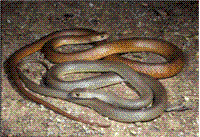Family
Elapidae (venemous land snakes)
Genus
Pseudonaja
Species
textilis
Threats/Control Methods - Regional
Eastern Brown Snakes are often killed by people, on farms or in gardens. This need not happen, as the snake will only attack if provoked.
Threats/Control Methods - Local
Eastern Brown Snakes are often run over on roads on the suburban fringe, close to farmland or bushland.
Local/Urban Actions
To discourage Eastern Brown Snakes from taking up residence in urban areas, lawns and gardens should be well maintained and wood and other debris should be removed. However, these actions may reduce the abundance of other reptiles.
Common name/s
Eastern Brown Snake, Common Brown Snake
Distinguishing Features
The Eastern Brown Snake is slender, but can grow to lengths of more than 2m. It has a small head. The snakes' colouring ranges from tan, through brown to almost black. The underside is pale yellow, with small dark-orange blotches. Adults tend to be unpatterned. Juveniles have quite a different appearance to adults, with a black head, yellowish body and often narrow black bands across the body and tail.
Similar Species
There are a number of other snakes which occur in the Canberra region which can be confused with the Eastern Brown Snake. Confusion is especially common between juvenile Eastern Brown Snakes and other species. The Black-headed Snake (Suta spectabilis dwyer©) has a much darker body and tail than the juvenile Eastern Brown. Juvenile Eastern Brown Snakes are also mistaken for Highland Copperhead (Austrelaps ramsayi), however, the copperhead doesn't occur in the Canberra urban area. The Mainland Tiger Snake (Notechis scutatus) is another snake which can be confused with the juvenile Eastern Brown, although like the Highland Copperhead, Mainland Tiger Snakes do not inhabit the urban areas of Canberra. The head of the Mainland Tiger Snake is bigger than the Eastern Brown, and when threatened, tiger snakes will hiss loudly, and flatten their head and neck.
Distribution
The Eastern Brown Snake occurs over much of Eastern Australia, throughout Queensland, NSW, ACT and Victoria. Populations of the snake also occur in South Australia and the Northern Territory.
Country of Origin
Australia
Survey Techniques
Visual searches and pitfall trapping
Conservation (Pet/Pest) Status - National
A common snake throughout much of Australia.
Conservation (Pet/Pest) Status - Regional
The Eastern Brown is the most common large snake seen in this area, especially prevalent in agricultural areas. The Eastern Brown Snake, like all native reptiles, is protected under the Nature Conservation Act 1999.
LSCCES Population
Often will pass through areas on the urban fringe during Spring and Summer, but generally will not linger due to lack of food and secure habitat.
Associated vegetation community
Grasslands, woodlands and dry sclerophyll forests.
Limiting Resources
Requires suitable water and food resources, but has thrived in the environments created by land clearing.
Breeding
The Eastern Brown Snake mates in Spring, with the mating season including combat rituals between males. The snake lays 10-35 eggs in early summer, with the juveniles hatching in late summer. The snake generally lays in existing burrows or under large rocks.
Behaviour
Usually diurnal but can become nocturnal during very hot weather. The Eastern Brown will seek shelter over winter and may hibernate in groups. Can strike quickly if threatened, but will usually retreat quickly from humans.
Functional Group
Food Species
Small mammals including mice (Mus domesticus) and rabbits, nesting birds, frogs, reptiles including Tiger Snakes and Bearded Dragons and reptile eggs.
Predators
Predators of the Eastern Brown Snake include raptors (birds of prey) and Red Bellied Black Snakes.
Interesting Fact
Constriction is used while the venom takes effect.
Eastern Brown Snakes are very venomous, being capable of delivering a lethal bite. They are very shy however, and will attempt to retreat before attacking humans.
Snakes play an important role in maintaining a healthy ecosystem.
References - (reader suitability of references, P=Primary teachers, S=Secondary students, T=Tertiary students and researchers)
Books:
Bennett, R. 1997. Reptiles & frogs of the Australian Capital Territory. National Parks Association of the ACT, Woden. P, S, T
Lintermans, M. and Osborne, W. 2002. Wet & Wild: A Field Guide to the Freshwater Animals of the Southern Tablelands and High Country of the ACT and NSW. Environment ACT, Canberra. S, T
Wilson, S. and Swan, G. 2003. A Complete Guide to Reptiles of Australia. Reed New Holland, Sydney. S, T
Internet:
Greer, A.E. 2006. "Encyclopedia of Australian Reptiles". Australian Museum Online Thttp://www.amonline.net.au/herpetology/research/encyclopedia.pdf [Last accessed 14/3/07]
Environment ACT 2005. "Information Sheet: Living With Snakes" S, Thttp://www.environment.act.gov.au/__data/assets/pdf_file/18843/Living_with_Snakes.pdf [Last accessed 14/3/07]
Researchers: Ian Rayner and Adam Houlden

 Top
Top Top
Top